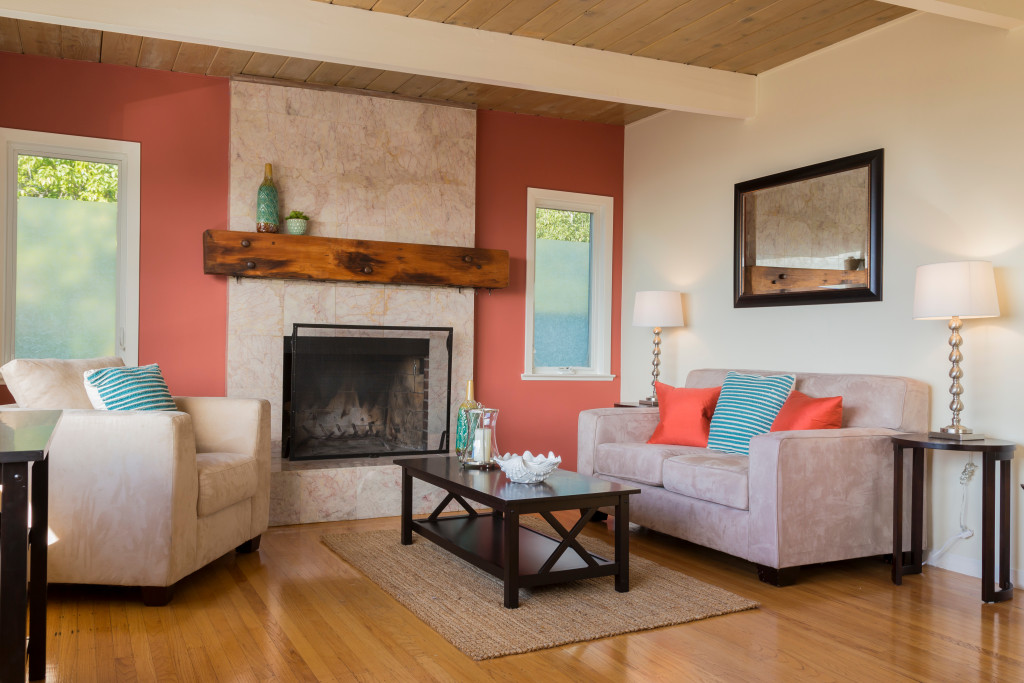We all need a haven where we can retreat, be it someone’s else house or our very own apartment. This is why the atmosphere of every living space is so important. And even though you might not think so at first glance, paint affects that atmosphere significantly.
Interior decoration has proven time and time again how powerful color can be to make the atmosphere better or worse. If you want to give your interior a new look without overhauling everything in sight, just paint.
With the perfect shade, you can change up your space instantly. Think about it: colors affect our moods much more than we realize sometimes. To create a warm yet modern vibe, try deep eggplant purple walls with clean white furniture. You can also play with different tints if you want something lighter but bold enough for an accent wall. For example, pale lavender gives off a relaxing feel, whereas light peach creates an aura of coziness.
But how do you pick the right color? It could be difficult since there are thousands of different hues out there. Paint colors affect any given space in more ways than one, especially bold ones with lots of contrast.
Therefore, you want to give your home a new look or refresh it. You might be considering giving your walls a fresh coat of paint. And that’s great because there are so many colors to choose from.
Before deciding on the best shade for your home’s interior, here are some things you must consider:
Your Current Furniture
To begin with, you must take into account your current furniture to ensure that it will be well-accented by the paint color you choose. Different colors look great on different types of furniture. This is why it’s essential to consider what you already have in your space. If your pieces are dark and heavy-looking, you might want something light. If they’re lighter, opt for a bolder shade to make your interior pop.
However, picking the right paint color for your furniture can be a difficult decision. You don’t want to use a bold, bright color only to find out that it’s clashing with the color of your sofa.
In case you already have lighter pieces in your home, darker colors would work well for them and vice versa. For example, a dark shade is very flattering against a light-colored couch or any other piece of lighter furniture you might have in your bedroom. On the other hand, white walls look great when paired with brown or black wooden furniture because they make everything stand out more, especially if glossy materials like lacquered wood.
The Size of Your Room
It may sound counterintuitive, but sometimes larger rooms require smaller paint shades. If your room is filled with a lot of light and space, opt for something delicate, and you’ll have a pretty interior.
For instance, a subtle shade of blue would work well in an entryway or bedroom because it’s not too overwhelming for a larger space. If the paint is too dark, it might make the room look smaller and lose its sense of space.
How Much Natural Light Your Room Gets

Just like furniture, you need to consider the lighting of your space because that has a significant impact on how colors are perceived. For example, if you have lots of windows with natural sunlight pouring in during the day, you can get away with bolder colors since they will highlight all the beautiful details of your interior design.
Also, keep in mind that colors appear lighter when there’s the sun, so don’t be afraid to go an undertone brighter than what you’d expect. On the other hand, if there isn’t much light coming into your place (or it’s artificial), opt for darker shades which often result in warmth.
Since most homes receive abundant natural light throughout the day, consider choosing a shade that reflects this lighting or is darker so that the difference in shades will not be too noticeable if there is no direct sunlight coming in.
If you want to use curtains, you should go for lighter shades to make your home brighter and welcoming. This way, when you open up your curtains during daylight hours, the color of your walls will be the least influential of these three elements (furniture, lighting, and wooden flooring).
The Decor in Your Home
Consider the decor in your home before choosing a paint shade to ensure that everything will blend seamlessly together. You want to put harmony and coherence in every room, so make sure there are no jarring colors which could only lead to an unpleasing sight.
Make sure your walls and furniture match by choosing a shade that goes best with them both. For instance, red walls go well with wooden or marble furniture, especially with gold details, because the color’s warmness will complement metal accents in your interior design.
On the other hand, cool tones of blue and gray work well together in an entryway or kitchen where lots of natural light comes. If you want something more versatile for any occasion, you can add neutral vintage embroidered throw pillows, which you can also pair with any other color.
The Color of the Wooden Flooring
Lastly, take into account the color of your interior’s wooden flooring. If it is dark, you must choose a shade that does not contrast too much with it, or else your choice will end up looking too bright for your taste. If it is light, though, you may use any other color because this difference in shades should not be very noticeable.
We all need a place to retreat from the rest of the world when times get tough. The perfect living space is everything about atmosphere and comfort, and colors play an instrumental role in creating that environment. Now, you know how powerful color choice can be when making the perfect atmosphere for every dwelling.







